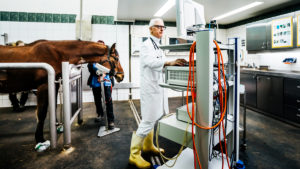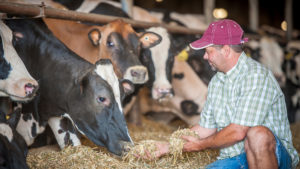From companion to large animal care – here’s how Apiam’s knowledge of rural vet clinics is driving growth

Pic: sinology / Moment via Getty Images
A thorough understanding of the operations of a rural veterinary clinic, along with communities Apiam serves, has proven to be a successful formula.
The veterinary needs of local communities has been credited as a key factor in the success of Australia’s largest regional vet network Apiam Animal Health (ASX:AHX), which now has 45 clinics and more than 62 business locations.
Speaking with Stockhead recently, managing director Dr Chris Richards highlighted that regional veterinary clinics operate differently to their city counterparts.
There may be up to 20 vets in large regional clinics — which may have two to three branches in smaller townships within a 50km radius, he said.
“City clinics tend to be two or three-person clinics, although some can be larger. They tend to do basic companion animal needs, with major surgery referred on to a specialist or after hours to an animal emergency centre,” Richards said.
“If you look at somewhere like the eastern suburbs of Melbourne, there’s around 15 or 20
specialists such as eye surgeons, cancer specialists, orthopaedic surgeons. And many city veterinarians in a general practice are doing general health care and surgery before often referring.”
“In regional practices vets are doing their own after hours, emergency care, and advanced procedures but also treating a greater range of species from companion animals to farm animals, horses and wildlife.”
Rural vets share the ups and downs of their communities
Richards said country veterinarians also often socialise with their clients and are very much part of their local community.
“As a vet you go to football or netball training and you’re with your clients, you’re in local volunteer groups with your clients and are very much entrenched in the community,” he said.
“A lot of our vets and staff have their own farms or horses, they’re on different industry bodies representing the agricultural sector, such as Dairy Australia.”
“It has its positives but also negatives because vets tend to wear their heart on their sleeve and absorb the ups and downs of what’s happening in their communities.”
Apiam working to support welfare of regional vets
It is with an understanding of the toll the industry can take that Apiam is working to ensure the mental wellbeing of its vets. The company has various measures in place to help reduce the grim statistic that vets are four times more likely to die of suicide than the general population.
Apiam has initiated its proprietary software-based triage service to reduce the exhaustion of rural vets, who have traditionally been on call 24/7.
“We are increasing our ratios of support staff per vet to enable nurses to take on some of the tasks, and we foster a collaborative approach. That means we can have six to 10 clinics in a region, with vets moving around as needed based on their skillset, which is a real strength,” Richards said.
Richards said while being a rural vet certainly has its challenges it can be deeply rewarding.
“From vets who want to care for companion animals to those who want to look after larger animals they’ve generally got more ability to do more procedures than if they were in a general practice in the city,” he said.
“One of the main motivations for vets is professional development which we have a huge focus and in most cases that far outweighs remuneration and monetary incentives.”
Apiam goes where others fear to tread
While veterinary corporates have tried to move into Australian rural areas before, most have not succeeded.
“It just hasn’t worked, and we’ve seen corporates close their clinics down after three or four years because attracting a vet to a rural area and operating a rural clinic is totally different to the city,” he said.
“Our management and leadership team are all rural people so it’s in our blood, many of us grew up on farms plus many have been practicing rural vets. Having vets run veterinary services can make a big difference to understanding their needs are and what drives them.”
Richards said rural veterinary clinics have changed substantially over the years, with an increase in companion animals to more than 50% in most clinics.
“Most of our clinics when acquired were predominantly production animal clinics, so we’ve had to invest heavily on resources for companion animals to match those available in city clinics,” he said.
“This enables us to provide services to our local communities where previously they would have had to take these animals to city specialist clinics”
Rise of female vets a major change to industry in recent years
By far one of the biggest changes has been a larger proportion of female vets. Apiam’s veterinary workforce is 70% female, with a number of clinics with 100% female veterinarians.
“Around 25 years ago there would have been around 70-80% male vets in rural practices,” Richards said.
“A large percentage of university graduates are female so the industry and attitudes are changing.”
Herd health programs a priority as animal care expands
Richards said their clinics were undertaking a lot more herd health programs in addition to the individual animal care, and emerging areas such as biosecurity, sustainable production, antimicrobial stewardship, and socially acceptable husbandry practices.
He said vets were working as part of a farm business with other consultants like geneticists and nutritionists, while also being involved in data analysis and adopting new technologies such as remote consulting and artificial intelligence.
“Certainly, in large animal care vets are using a lot of time using their brains rather than brawn and are involved in analysing data, staff training, and developing preventative health programs,” he said.
This article was developed in collaboration with Apiam Animal Health, a Stockhead advertiser at the time of publishing.
This article does not constitute financial product advice. You should consider obtaining independent advice before making any financial decisions.
Related Topics
UNLOCK INSIGHTS
Discover the untold stories of emerging ASX stocks.
Daily news and expert analysis, it's free to subscribe.
By proceeding, you confirm you understand that we handle personal information in accordance with our Privacy Policy.








